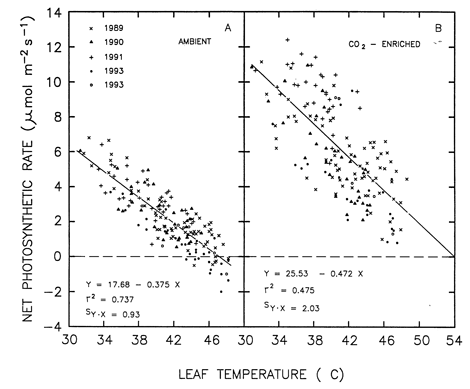Reference
Idso, S.B., Idso, K.E., Garcia, R.L., Kimball, B.A. and Hoober, J.K. 1995. Effects of atmospheric CO2 enrichment and foliar methanol application on net photosynthesis of sour orange tree (Citrus aurantium; Rutaceae) leaves. American Journal of Botany 82: 26-30.
What was done
Well watered and fertilized sour orange (Citrus aurantium L.) trees were grown from the seedling stage out-of-doors at Phoenix, Arizona (USA) in clear-plastic-wall open-top chambers that were continuously maintained at mean atmospheric CO2 concentrations of either approximately 400 or 700 ppm for 5.5 years, while during the warmest parts of some of the hottest days of summer, rates of net photosynthesis of fully-expanded outer-canopy sunlit leaves and the temperatures of those leaves were concurrently measured.
What was learned
The figure below portrays the results of plotting the net photosynthesis measurements against leaf temperature. Based on the linear regression lines fit to the data, it can be determined that the 75% increase in the air's CO2 content led to a 75% enhancement of leaf net photosynthesis at a leaf temperature of 31°C, a 100% enhancement at a leaf temperature of 35°C, and a 200% enhancement at 42°C. At higher leaf temperatures, it can be seen that the net photosynthetic rate of the foliage growing in ambient air dropped all the way to zero at 47°C (making the CO2-induced enhancement of photosynthesis at that point essentially infinite), and that it actually became negative thereafter (which, if prolonged, would ultimately lead to plant death). In the CO2-enriched trees, on the other hand, the net photosynthetic rate of the foliage was still substantial at 47°C; and the regression line for those trees suggests that their mean rate of foliage net photosynthesis likely would not have declined to zero until leaf temperature reached 54°C, which is approximately 7°C above the upper-limiting temperature for positive net photosynthesis in the trees that were grown in ambient air.
Leaf net photosynthetic rate vs. leaf temperature for the foliage of sour orange trees growing in air of either 400 or 700 ppm CO2. Adapted from Idso et al. (1995).
What it means
If earth's air temperature continues to rise significantly in the future - for whatever reason - we can only hope that the air's CO2 content continues to rise right along with it; because elevated concentrations of atmospheric CO2 are a powerful antidote for the ill -and sometimes even deadly - effects that might otherwise be experienced by much of earth's vegetation, which thesis is more comprehensively demonstrated by the materials discussed in our Editorial of 15 October 1999, our major report The Specter of Species Extinction (2003), and our review of the paper of Beerling and Mayle (2006).
Reference
Beerling, D.J. and Mayle, F.E. 2006. Contrasting effects of climate and CO2 on Amazonian ecosystems since the last glacial maximum. Global Change Biology 12: 1977-1984.





